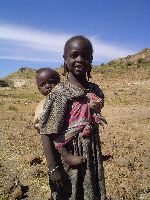“Asia-Pacific can lead the world to end the AIDS epidemic”
“Asia-Pacific can lead the world to end the AIDS epidemic”
Shamshad Akhtar and Michel Sidibé
This century opened with the AIDS epidemic at its peak. Now, 15 years later, new HIV infections are down significantly worldwide, while access to treatment has cut the number of AIDS-related deaths by more than a third. These achievements are no accident. In 2000, Governments committed to the Millennium Development Goals (MDGs) which addressed the greatest challenges of our time, including halting and beginning to reverse the spread of HIV. The progress we have seen since then fulfills a promise and proves, that strong leadership and sustained engagement deliver results.
Still, much more remains to be done. This year, the international community will need to, once more, show bold action in charting a path forward on HIV. In September, as the deadline for achieving the MDGs comes to an end, governments will decide on a new set of sustainable development goals for the period after 2015. To help define the future of the HIV response in this new era, Governments across Asia-Pacific together with civil society and other partners are gathering in Bangkok this week at a major regional meeting convened by the United Nations Economic and Social Commission for Asia and the Pacific (ESCAP), in partnership with the Joint United Nations Programme on HIV/AIDS (UNAIDS), the United Nations Development Programme (UNDP) and other organizations.
Since HIV first emerged, the Asia-Pacific region has been a leader in demonstrating political commitment and investing resources to address the epidemic. Initiatives like Thailand’s programme to promote safer sex have been widely replicated. However, if the region is to continue to be a pioneer, Governments must urgently confront several challenges head-on.
Perhaps the biggest challenge is ensuring sustainable financing for HIV programmes. More than US$ 2 billion has been mobilized for Asia and the Pacific, but international donors account for nearly 40 per cent of the funding. This is not sustainable. While external donors have played a critical role in providing seed money for HIV programmes, countries cannot forever rely on international funding.
Clearly there is scope for greater domestic spending given the region’s economic dynamism. China is an example of what is possible. Between 2006 and 2013 the country increased spending on HIV programming seven times. Now, due to its committed leadership, China has made the transition to full self-reliance, even in the face of one of the most serious AIDS epidemics in the region. While some low-income countries will continue to need support from international donors, Governments must share responsibility and invest significantly. Otherwise, they risk losing the gains they have worked so hard to secure. They must pay now, or pay forever.
While larger domestic investments are needed, it is equally important to get more value for money. As ESCAP member states have recognized in past resolutions, the populations most affected by the HIV epidemic include sex workers, men who have sex with men, transgender people, and people who inject drugs.
Yet, despite this knowledge, many countries are underfunding precisely those programmes which would make the most impact. Only an estimated 8 per cent of overall AIDS spending is for HIV prevention among key populations at higher risk of HIV exposure. To get results, health authorities must work with civil society to promote community-based HIV services for the people who need them most. Two-thirds of key populations don’t know their HIV status. It is important to scale up HIV testing by offering simple but highly effective tests in communities.
However, ensuring a full return on investments doesn’t only depend on funding. Stigma and discrimination prevent people living with HIV and key population groups from accessing essential services. Almost every country in the region has laws, policies or practices that hinder the AIDS response. For example, 42 countries criminalize some aspect of sex work and 21 countries prohibit same-sex sexual relations. Such laws and policies are unjust, prevent social development and increase risky health behaviour. They must be reversed.
1.5 million people living with HIV in Asia-Pacific are accessing life-saving treatment. While this is a big success, it poses a challenge for the sustainable funding of the AIDS response. To compound the problem, millions more people still need to receive treatment. Governments will, therefore, need to meet the demand for more treatment in the coming years, including new and more expensive antiretroviral treatments (ARTs).
The Asia-Pacific region has the potential to meet this challenge. It is a hub of entrepreneurial and scientific innovation, which manufactures affordable HIV treatment and other commodities on a large scale. Indian manufacturers, for example, already provide the bulk of the generic ARTs used in low-and-middle income countries, helping to drive down the cost of HIV treatment across the globe. Going forward, we will need to continue this trend towards reducing the price of ARTs, discovering new and more powerful treatments, and hopefully one day finding a cure.
Ending the AIDS epidemic in Asia and the Pacific is possible, as long as countries have the courage and wisdom to take the right kinds of action. Governments must invest significantly more in the AIDS response. They must increase the impact of their investments by refocusing their efforts on the people at higher risk of HIV infection. Finally, they must promote scientific innovation and affordable access to life-saving medicine. Such bold actions will not only accelerate the progress made in Asia and the Pacific in responding to HIV in the new millennium; they will also help propel the world to end the AIDS epidemic, once and for all.
ends


 UN News: Ceasefire The Only Way To End Killing And Injuring Of Children In Gaza
UN News: Ceasefire The Only Way To End Killing And Injuring Of Children In Gaza ICHRP: US-Japan-Philippines Trilateral Summit Makes The Philippines A Battlefield For US-China Conflict
ICHRP: US-Japan-Philippines Trilateral Summit Makes The Philippines A Battlefield For US-China Conflict East West Center: Environmental Journalist Alexander Kaufman Receives East-West Center’s Inaugural Melvin M.S. Goo Writing Fellowship
East West Center: Environmental Journalist Alexander Kaufman Receives East-West Center’s Inaugural Melvin M.S. Goo Writing Fellowship Compassion in World Farming: Octopus Farm Must Be Stopped, Say Campaigners
Compassion in World Farming: Octopus Farm Must Be Stopped, Say Campaigners UN News: Shipwreck Tragedy Off Djibouti Coast, Drone Attacks Continue At Ukraine Nuclear Plant, Madagascar Cyclone Update
UN News: Shipwreck Tragedy Off Djibouti Coast, Drone Attacks Continue At Ukraine Nuclear Plant, Madagascar Cyclone Update UN News: Aid Lifeline Reaches Sudan's Darfur Region In Bid To Avert ‘Hunger Catastrophe’
UN News: Aid Lifeline Reaches Sudan's Darfur Region In Bid To Avert ‘Hunger Catastrophe’